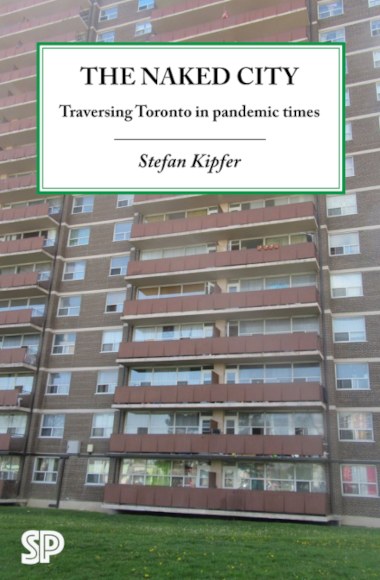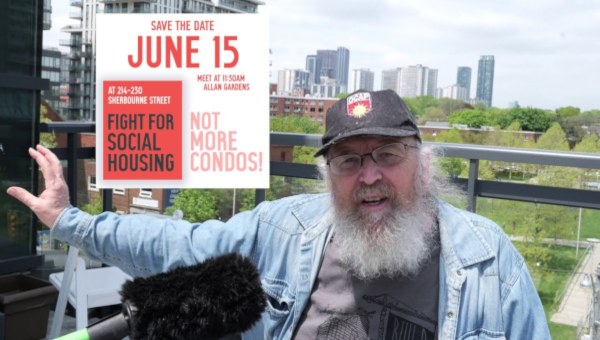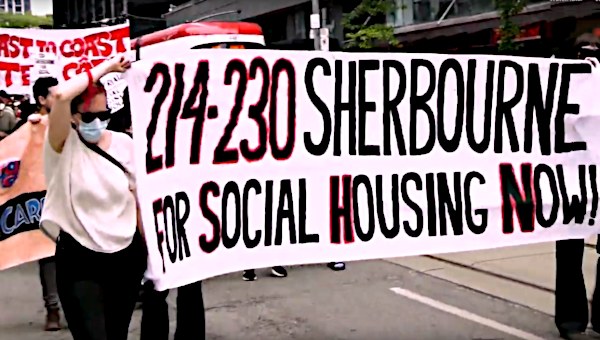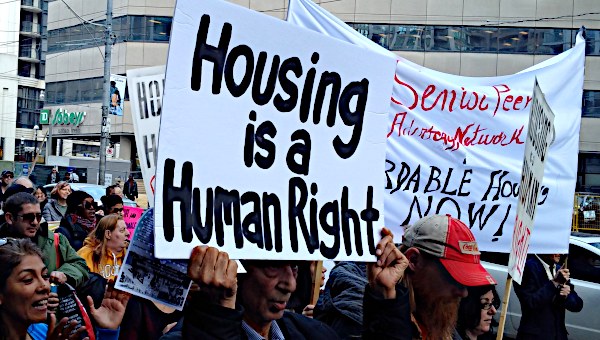Did Someone Say Housing Supply? A View from Toronto
It is impossible to deny that we are experiencing a housing crisis in Canada, and a particularly acute one in major metropolitan regions such as Toronto. Evidence of this crisis and how it has grown is ample and widely available in even mainstream accounts. From data published by governmental and non-governmental organizations, we can learn a great deal about the breadth and depth of the housing crisis in places like Tkaronto/Toronto. We know, for example:
- that the approximate number of shelter-less people has multiplied several times since the 1980s, when homelessness – which affects many more people than people in the street – returned to be a chronic feature of urban life.
- that street-level homelessness has generated a new, heavily if unevenly policed landscape during the COVID-19 pandemic: highly visible encampments across central city parks, not only in ravines and under bridges and highways.
- that waiting lists for social housing (public housing and supportive housing) have multiplied since the 1990s (when social housing production in Ontario was brought to a halt) and again during the 2010s (when austerity was entrenched further). Despite efforts to take people off the list by administrative means, they remain stubbornly long.
- that the physical state of disrepair is an important feature of the housing crisis and is particularly worrisome level in public housing, which was downloaded to municipalities in Ontario at the turn of the century and left Toronto Community Housing, by far the largest public housing authority in the province, with a multi-billion dollar repair backlog and a significant number of unsafe, unusable buildings.
- that market housing is increasingly out of reach for many inhabitants. Between 1991 and 2016, housing unaffordability (relative to income) increased continuously. In the Toronto metropolitan area, the proportion of households paying between 30% and 50% (more than 50%) of their budget on housing increased by 90% (138%).
- that spiralling increases in the cost of ownership housing have created a situation where in 2022, it takes a household income 2.5 times larger than the median to carry the cost of buying a house in the Toronto, Hamilton and Vancouver areas.
- that tenants are particularly impacted by this affordability crisis. An ever-widening gap between wages and market rents has made it impossible for minimum-wage earners to afford apartments in almost all neighbourhoods in Canadian cities. In Toronto, it has resulted in a staggering loss of apartments affordable for moderate and low-income households between 2006 and 2021. After another surge of 24% between 2021 and 2022 following the end of pandemic stay-at-home orders, one-bedroom apartments in Toronto and Vancouver were listed at $2500 and $2600 respectively in late 2022.
- that what some call naturally occurring affordable housing (NOAH) stocks in low-end private rental markets are eroding across the country. Between 2011 and 2016, Canada lost about 322,000 deeply affordable units (with fees below $750/month). This means that for every additional affordable housing unit created by government-sponsored programs over the same five-year period, 15 were lost to higher-end conversions.
- that the housing crisis is everything but an equal opportunity crisis. While affecting a large part of the population negatively, it has devastating effects on Indigenous people, low-income and non-White labouring populations, women, gender-non-conforming inhabitants, immigrants with precarious legal status, and people with disabilities.
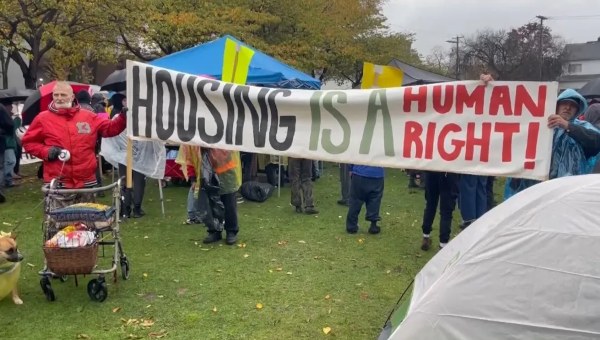
Over the last generation and a half, a succession of typically moderate and occasionally far-reaching demands have been made to mitigate or confront the housing crisis: reinstate full rent control, build emergency shelters, return to social housing production, regulate for-profit housing production, set up land trusts, advance the call for “land back,” and complement any housing initiatives with good jobs, living wages, and accessible and affordable or free transit. These demands could be joined to call for the decommodification and decolonization of housing. But over the last few years, “increasing the housing supply” – now code for increasing the supply of market housing – has become the only widely audible recipe offered in response to the housing crisis. In 2022, this particular recipe has been put on the table in radicalized form by the Ontario and British Columbia provincial governments.
Which Problem is “Housing Supply” Supposed to Solve?
In general, there is nothing wrong with calls for more housing. After all, the housing crisis means that many distinct (if complexly related) social needs go unmet today. One could say, then, that increasing the “housing supply” might be a way to meet a wide-ranging and growing demand for well-built and accessible shelter. In practice, however, it is unclear whether the call to boost the “housing supply” is about meeting social needs for housing at all, or, if it is, which particular social needs are being targeted.
Adding beds to the emergency shelter system, building supportive housing units, repairing public housing estates for existing tenants, putting a housing coop on public land, building condominium towers or turning green fields into low-density subdivisions are qualitatively different initiatives. They do not address the same housing problem and do not benefit the same social groups. To put it bluntly: while building robust supportive housing can keep many from dying young on the street, building a high-end condo tower helps suppliers (developers and their financiers) expand their rent-based business while allowing buyers (investors, rich owners) to park their money and expand their wealth, and politicians to play a political calculus of pleasing propertied electors, quite possibly at the expense of those desperate to find a roof over their head or pay the rent to avoid eviction.
Will “Adding Housing Units” do it?
In What Sense is the Housing Crisis a Housing Problem?
Mainstream discourse in Canada (also debated elsewhere) has claimed that the housing crisis is a quantitative one. In Ontario, it has been argued that the crisis would only be solved by adding 1.5 million housing units over the next decade. While the technique used to set this target has been controversial (as it wasn’t based on the local characteristics of household formation), more problematic is that “supply” is presented as an unqualified good. But can adding new market units make the market responsive to people’s wages, household conditions, locational and overall needs? And are developers and financiers interested in and able to supply the housing required to address the needs of people impacted the most by the housing crisis?
Let us start with a few basics. Not all approaches to dealing with housing problems require new housing units, for at least two reasons. First, housing is not only about being “well-housed,” being equipped with a thing called housing, that is to say, shelter: a durable and accessible roof over your head. Housing is also an activity inhabitants pursue. It describes how people use and adapt buildings, how they give meaning to shelter and how they organize their lives in part by appropriating physical environments and landscapes. The act of housing is also aspirational and future-oriented. We can see, then, that the quality of housing depends also on the quality of the social relations that shape daily life.
Having a roof over your head is fundamental. But shelter does not protect anyone from gendered domestic violence. It does not come with a decent job. It does not isolate you from climate change, nor does it shield you from racism. It says nothing about how your building is run and where your rent goes. It is silent about the physical or social distance (or proximity) between you and your neighbours, your neighbourhood and other social spaces in an urban area. Being sheltered tells us little about mobility, your capacity to move around large urban areas with ease so that you can get to work, meet medical appointments, and pick up quality, affordable food. To add a concrete example: supportive housing is only supportive to the extent that the medical, social and psychological supports provided are well-rounded, reliable and enduring. When people with disabilities or ex-prisoners lack an entry point to supportive housing in their community, they may be sent to segregated settings elsewhere. They are uprooted and can’t live autonomously, which may evoke or recreate the dependency and surveillance of the carceral state. Being "placed" in confined living situations like group homes or other institutions makes it difficult to make a living and reproduces precarity.
Second, the housing crisis is not only a housing problem. There is no question that crucial aspects of the current housing crisis – notably the crisis of affordability and the steady increase in the number lacking shelter – are caused by our housing system. But not all. For one, housing affordability is a relational concept. It describes the relationship between housing and other social and material realities, including those that shape people’s (in)ability to juggle housing costs along with the cost of other essential expenses (e.g., food, childcare and transportation) within a limited income. Thus, the housing crisis also results from bad jobs, stagnating wages, precarious employment, and stubbornly high poverty rates; from the difficulty of staying in good health and keeping your household together in light of degraded, unavailable or overly expensive public services for child care, health care, education and immigration services; and from the ongoing realities of settler colonialism and racialization that combine with and accentuate class and gender inequalities by segmenting labour markets and enacting forms of state and police violence, including racial profiling.
In short: to seriously tackle housing problems, housing dynamics must be seen as one part of larger capitalist realities, notably the restructuring of relations of (re)production that has generated social polarization over the last generation.
Who is Defending Existing Forms of Housing?
Supplying new decent, affordable, and secure shelter to those who don’t have it is crucial. But a significant number of housing problems are caused by the loss of existing housing. When the police clear tent encampments, those evicted are forced to find another campsite because shelters are full or because social or supportive housing units are not available. When tenants in the private rental market get renovicted because landlords can get away with it, they find themselves on the street, on someone’s couch, in a different town, or, if they are lucky, in a (much) more expensive apartment. When public housing tenants are evacuated from a crumbling building, their new digs may be only marginally better than the old one. Also, they may not be able to move back to their neighbourhood because renovations take too long or because their housing estate is destroyed (“revitalized”) to make way for new inhabitants that can afford the new condos and townhouses that are built to swamp the rebuilt subsidized housing units. When existing long-term rentals are converted into full-time short-term rentals for tourists, housing availability is reduced. This induced scarcity affects vacancy rates and therefore rental fees in more than one way. For instance, a loosely regulated short-term rental market encourages landlords of long-term units to bid up tenants’ rental prices to make up for the opportunity cost of not listing their units on platforms such as Airbnb for higher profits.
Frequently, someone’s housing loss is another’s housing gain. The “ratepayers” (a term that reminds us of a time when only property owners were citizens) who call their councillor or write to their neighbourhood paper to complain about tents in the park consider encampments incompatible with their quality of (housing) life. Those who can afford the higher rent in the refurbished rental building can only move in because their renovicted predecessors were forced out. When public housing authorities are starved of the capital budgets with which to renovate buildings for existing tenants, governments can maintain or expand budgets for services such as policing or roads that have no redistributive function. In short, defending existing (and genuinely affordable) housing, tenants’ rights and shelter options are vital to push back against the housing crisis. In addition, there is an urgent need to replace the carbon-intensive demolition-rebuilding cycle with strategies to rehabilitate the housing stock wherever possible.
What About the Supply of “Market Housing”?
The expression “housing supply” may have multiple or ambiguous meanings. The most common meaning today is “market housing supply.” But market housing does not, as we will see, bode well for those concerned about housing affordability for the working class, let alone low-income working-class inhabitants. The demand to boost ownership housing (and, to a lesser extent, market rental housing) has been a daily staple of mainstream media debates for years. In the City of Toronto, both the 2018 and the 2022 municipal election campaigns were saturated with it. Provincial politics has also shaped it, most aggressively again since the election of the Ford government in 2018 and its effort to further entrench market orientation into municipal operations and various new mayoral powers.
The prominence of market supply arguments is not surprising, for three reasons. First, they are most forcefully made by the organizations representing the major players shaping housing markets (developers, builders, banks and other financial firms) and the cross-sectoral business lobbies within which these players represent a powerful force. In Ontario, the Building Industry and Land Development Association, the Toronto Region Board of Trade, and the Ontario Chamber of Commerce have called to eliminate restrictions on their members’ capacity to build, sell and operate ownership and market rental housing. Second, there are few politicians, journalists, professionals, and non-profit organizations who object to the primacy of the private housing industry and its products. They often articulate their support of “the market” through a critique of municipal planning (mainly zoning) and a call for inclusionary zoning. Third, there are many people in this country – and in urban areas like Toronto – for whom non-market housing is barely imaginable because it is absent from their daily life.
How New is the Call for Market and Ownership?
Following the news and the frequently shrill calls to increase the market housing supply, one could be forgiven to think that the demand for market housing is novel or innovative. Nothing could be further from the truth. The transformation of common land (and housing) into privately owned and marketable quasi-commodities predates Confederation. Turning land, farms and housing into privately owned or appropriated “real estate” was a key foundation of Canadian state and society. It propelled colonial settlement. It helped build labour markets by undermining people’s capacity to sustain themselves independently, without selling their capacity to work to others for a wage. And, key for our purposes, it blocked the possibility of “planning without property.” In fact, many towns that emerged after the mid-19th century were built from the outset by landowners, speculators, railway and resource companies, most starkly in the western half of the continent. How? By forcing Indigenous nations off the land by means of genocidal violence, fraudulent treaties and techniques (surveys, land registries, courts, police powers) through which Crown and private property claims could be established and enforced.
For much of the history of settler state Canada, propertied housing – and all its colonial, class-based, gendered and racialized dimensions – was the only item on the menu, limited only by those interventions (fire and building codes, infrastructure such as roads, water/sewage, hydro, transit) designed to put competition among owners and typically small-scale builders on sturdier and more predictable foundations. Non-profit rental housing (social housing) was only built at a significant scale starting in the middle of the 20th century (in fact, the 1960s), with the implementation of hard-fought provincial-federal public housing programmes and the cooperative housing programmes that have complemented public housing since the 1970s.
Even in this period, social housing remained ‘residual’ – reserved for a very small part of the population. Similar to its US American counterpart, Canada’s housing policy continued to treat “real estate” as the normal conduit of housing provision. It focused on sustaining and subsidizing market and ownership housing with a range of interventions: infrastructure, tax incentives and mortgage insurance. With the end of large-scale public housing provision in the 1970s, the devolution of social housing from the federal to the provincial and, in Ontario, the municipal level in the 1980s and 1990s, non-market housing has become even less significant in the lives of Canadians, the (insufficient) proliferation of emergency shelters notwithstanding. In Ontario, provincial downloading in the late 1990s has condemned public housing to a slow death and left co-ops in a fight to maintain buildings and support low-income members. Particularly when defined as a proportion of average market rents, the current terminology (“affordable housing”) is a euphemism for a lack of non-profit housing, here and elsewhere.
Will the “the Market” Build it?
The bulk of housing produced in Canada is market housing; most of it is ownership housing. In fact, major urban regions – Toronto and Vancouver in particular – have undergone an incredible series of housing booms since the recession of the 1980s. The scale of these booms is difficult to grasp. In central cities, a big proportion of it is in the form of multi-residential buildings. In Toronto, the “condo boom” left a deep mark on urban landscapes, selectively supported by state-led and notably racialized processes to reconquer, redevelop and gentrify large public housing estates. This boom has survived both the 2008 financial crisis and COVID-19 pandemic. To illustrate: due to a record $19-billion in real estate investment, Toronto has far more cranes in the ground in late 2022 than any comparable urban region in North America.
Together with Vancouver, Toronto is now the most striking case of “tall and sprawl” (or “rise and sprawl”) urbanism on the continent. Here, central city housing booms are just one side of a coin that also includes “sprawling” development at the edges of the urban region. Land-extensive development comes in two, dynamically interdependent (not antithetical) vertical and horizontal forms. While in the postwar period, sprawling urbanism included significant doses of private and public rental buildings, today, the vertical component of residential sprawl takes mostly the form of condominiums (some of which are also sublet rented out by investor owners as especially expensive and weakly regulated forms of rental housing).
In places like Toronto, market housing has not been in short supply. But this supply is not ‘natural’, it has not dropped from the sky. It depends on conditions of profitability: the possibility of generating a return on investment in various forms of land rent. This possibility itself depends in part on state support. Next to the basic role of the state in guaranteeing private property claims to land, the key pillars of this support are infrastructure spending, provincial-municipal land-use planning and federal mortgage insurance, without which the postwar expansion of ownership housing to a segment of the working class would not have happened, and without which “the developers,” as we know them, would not exist at all.
Far from taking the state out of the housing business, neoliberalization has intensified the commodification of housing also by radicalizing state support for market housing in various ways: shrinking or ending support for non-market housing, eroding rent and zoning controls, encouraging the privatization of formerly semi-public housing such as student housing, and deregulating the financial industry to allow it integrate circuits of housing finance more directly into the operations of global finance than was the case in the postwar era. States (central banks and finance ministries in particular) have also underwritten the debt-based property boom of the last generation. How? By following low-interest monetary policies and bailing out banks and other companies that are no longer capable of covering bad debts (as happened during the 2008, housing-induced global financial crisis).
States have thus been active players in the “financialization of housing.” Building upon the postwar “mortgage finance” model that was pioneered in Anglo-America but became one key inspiration for World Bank development policy is a new stage in the commodification of housing that (1) reduces a growing proportion of market and ownership housing (and, in some jurisdictions, even social housing) to mere assets for hedge-funds and other financial firms involved in global financial markets, (2) pushes up expectations of profitability, thus intensifying pressures to raise rents, evict tenants or redevelop less profitable segments of the market, and (3) benefits a clientele that includes a large proportion of absentee owners, which results in shrinking occupancy rates and ‘zombie urbanism’: design features to accommodate remote, wealth-storing owners. Known in various cities, these related trends have been documented here, too, also in the segment of the rental market now run by Real Estate Investment Trusts.
Needless to say, tying housing policy to conditions of profitability is a risky, crisis-prone proposition, even more so when those conditions are mediated by global financial flows, as is currently the case. While allowing housing to be a vital source of land rent and one crucial receptacle of surplus capital in search of profitable investment opportunities, this approach has also contributed to the (highly uneven but long-term) process of turning the economic sectors tied to real estate (housing, land development, construction, architecture, urban planning) into an ever more decisive component – and source of crisis – of capitalist development at large.
All of this means that those asking for more market housing might not get it. Today, labour shortages, also in the construction industry mean that builders can’t build what they want. In turn, the return of monetary discipline and the end of extra-low interest rate policies rapidly erode the possibility of expanding market housing by ratcheting up debt on the corporate and the consumer side. Bubbles – the hyper-speculative, unsustainably debt-laden component of the housing boom that is highly significant in Canada, particularly in Toronto and Vancouver – may burst, turning the dream for market housing into a nightmare, once again. What is true for capitalism in general is also true for housing: booms make way for busts, big or small. While booms exclude growing numbers from the good times because of spiralling land rents, busts will deflate some housing prices but also depress new (market) housing production.
Does Market Housing Meet Social Needs?
Two points follow from the preceding discussion. First, governments may proclaim a desire for more housing but there is no guarantee that the private sector will build it as desired. In this sense, the demand for greater “market housing supply” resembles the demand for free trade agreements a generation ago. These agreements could not guarantee a continuous and peaceful expansion of international trade, as liberal internationalists had it then. They did however institute additional legal protections for investors operating transnationally. As with free trade agreements, the most concrete effect of the call for increasing market housing today is to further entrench the power of capital (the development industry) and its freedoms from taxation, zoning, flood control, green belt protections, conservation measures, progressive building regulations, rent controls, and limits on converting rental apartments into condos.
After other provincial initiatives (new highways, sprawl-inducing modifications to the provincial growth plan for the Toronto region, Minister’s Zoning Orders overriding local planning controls) that generated an anti-sprawl movement prior to the 2022 provincial election, Ontario’s current omnibus bill (“Building More Homes Faster”) is the latest example illustrating this point.
Second, the demand for more market housing in contexts like Ontario, where market housing has been the only game in town for a generation, is to administer the very medicine that has made the patient sick in the first place. To be blunt: building market housing is not the same thing as meeting social needs. Market housing means subjecting the provision of housing as human need (a “use value”) to the imperative of producing housing as a commodity for sale (“exchange value”). The Mexican experience with a “market housing supply” approach provides a poignant example of this tension. While millions of households acquired debt since the late 1990s to buy a home in the suburbs produced through a national policy of “enabling private markets,” many of such houses have been now abandoned as they offered little “use value” to families given location, lack of services or jobs, and rising debt burden. High vacancy rates contrast sharply with the situation of one-third of Mexicans still living in precarious housing.
The only intellectual approach which sees no tension between the use-value and the exchange-value side of market housing is mainstream (“neo-classical”) economics, for whom market prices express a neat balance between social need (demand) and the production of commodities (supply). It is this approach that is expressed in the journalistic article of faith concerning the iron law of (housing) supply and demand. Classical [political] economists like Adam Smith, analysts writing in the tradition of Karl Marx’s critique of classical political economy, and a range of heterodox economic traditions all know that there are tensions and contradictions between use and exchange value.
Subjecting land and housing to the imperative of exchange value opens up structural gaps between social needs and housing supply. In the first instance, it ignores a fundamental fact: land is not a commodity properly speaking. We can destroy many of the qualities of land when we divide it up or strip it bare to turn it into an object for sale. But we can’t produce it the way we manufacture widgets or buns. Finite, land (let alone land with specific qualities) can also not be multiplied at will. Private land ownership and land markets (whether destined for housing, agriculture or anything else) thus lend themselves to monopolistic tendencies for a particular set of reasons, undermining any idealized arguments about balancing demand and supply.
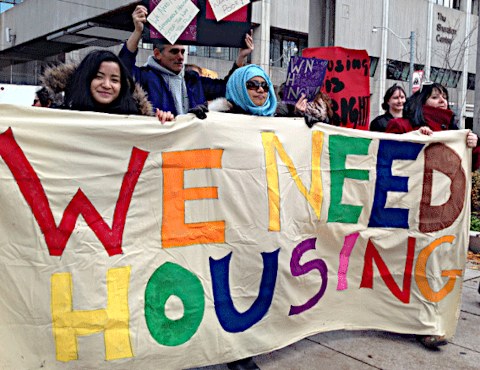
Also, profit-oriented housing degrades the product (by minimizing the durability and state of repair of buildings, for example) and deforms the practice of inhabiting (by making it impossible for tenants or owners to ignore economic pressures and market imperatives). Even when they only want to use their dwelling to live a decent live, occupants of market housing face the destabilizing and disciplining effects of, for example, landlord interests or interest rate movements in the capitalist economy as a whole. The empirical reality is that “the market” has never managed to provide shelter – let alone decent and stable housing – for everybody, not even at the height of the postwar boom, which was facilitated also with the state-subsidized expansion of ownership housing to segments of the working class.
With social polarization, neoliberalization, and the attack on social housing provision, the gap between housing needs and the housing supply has widened further. The (neo-) liberal dream of the “homeowner society” as a promise for stable, equitable and widely accessible housing so deeply rooted in Anglo-American housing policy has failed on its own terms. Today, in Canada, home-ownership rates are declining. Ownership housing markets exclude a large segment of the population. They allow investors – firms and a minority of inhabitants (including those owning multiple properties who are now aberrantly called “artisanal” landlords) – to “build equity,” thus contributing to growing wealth inequality. In turn, market rental housing offers no relief, becoming unaffordable for the working class and a growing segment of the middle class itself. As this situation shows, the main supply argument advanced by liberal economists (that expanding market housing will “filter down” to everyone eventually) does not hold.
Is Zoning a Problem? What Kind?
In the current debate about housing in Ontario and Toronto, zoning restrictions (and the interests and institutions sustaining it) are frequently cited as the culprit. A particular thorn in the side of the critics: zoning by-laws and official plans that protect low-density, detached or semi-detached residential zones (originally intended for “single families”) from other land uses. Called the “yellow belt” in the City of Toronto, these zones are accused of standing in the way of higher-density, multi-residential buildings or even just additions to existing buildings or lots.
So, let’s have another look at the problem of zoning.
- In technical terms, zoning is exclusionary by definition. By separating various activities (manufacturing, retail, residential life) from each other, zoning insists that each zoned district be off limits to at least some of these activities.
- The meaning of “exclusion” is not always the same. Zoning often is but does not have to be socially exclusionary. Zoning can be used to stop the conversion of industry or affordable housing. Distancing people from highways or waste dumps is not a bad thing; it is the lack of such distancing that signals environmental injustice.
- Zoning is not always effective. Zoning is not the only or the most important factor shaping development. Also, where there are formal rules, there are exceptions, amendments, and variances as well as informal realities. In Toronto, height and density restrictions are frequently bargaining chips, not prohibitions, allowing developers, councillors and planners to make deals in the development approval process.
- Social separation and exclusion do not need zoning. One of the most unequal, segregated and sprawling cities in North America, Houston, is known for having grown without formal zoning regulations (but with other, formal or informal restrictions).
As with other forms of state intervention, zoning is tied up with the class-based, gendered, racialized (and, on Turtle Island, also settler-colonial) relations that sustain capitalist society. In Euro-America, the move towards comprehensive zoning laws in the 20th century built upon more punctual experiments in the second half of the 19th century: creating spatial distance between housing and manufacturing, building exclusive residential enclaves explicitly off limits to minoritized groups (Indigenous, Jewish, Black, or Chinese people), or using parks, green belts or rail tracks as buffer zones to segregate between different classes and variously racialized groups. Permeating these early initiatives, one can detect, also in Toronto, a deep contradiction between the quest for new land rent and the desire to preserve existing uses of land.
Standardized zoning in the 20th century became an important mechanism (1) mediating competition among landed property interests, (2) regulating social conflict by structuring the spatial relations between dominant and subaltern social groups along lines of class and race in particular, and (3) especially in North America, consolidate the social power of propertied, low-density, and car-oriented residential districts. By the 1960s, however, zoning (as a “technique of separation” (Guy Debord) or a practice of “compartmentalization” (Frantz Fanon)) became subject to critiques focused on distinct realities that are not caused single-handedly by zoning but that zoning can codify and entrench: social segregation, the alienation generated by pulling apart human activities spatially, the gender roles assumed to rule life in zones reserved for “single families” (but not multi-occupant housing, typically the most affordable form of housing), and the polluting car-dependencies encouraged by distancing various activities.
In response to social movements critical of one or the other practice of spatial separation facilitated or coded by zoning, urban planning started to shift course. The critique of zoning has been part of the mainstream for decades. “Mixed use” is one term expressing a formal alternative to the practice of dividing urban space into zones occupied by single uses and built environments with formal properties measured by height, density, and lot size.
Is “Mixed Use” the Answer?
Like the critique of zoning in general, the support for “mixed-use” is socially and politically ambiguous. Historically, avant-garde modernists wanted to encourage (“condense”) radical change and revolution by maximizing the capacity of ordinary inhabitants to appropriate, adapt and transform the built environment instead of proscribing its functions (also with zoning). More recent critiques of single-use zoning can come along with a emancipatory critique of NIMBYism, the practice by which residents defend themselves (sometimes relying on zoning restrictions) against unwanted ways of using “their backyard”: basement apartments, social services, transitional housing, homeless shelters, student housing and apartment buildings. In this critique, there is no doubt that low-density zoning is only one part of a deeper reality that gives rise to NIMBYism: the defence of property values in an urban society where housing provision is based on private property and dreams of the good life focus on “home” ownership, real estate and various class-based, racialized and gendered aspirations of social distinction.
Today, however, the critique of zoning – and NIMBYsm – has changed colours. When used by Ontario Premier Doug Ford, the development industry and organizations that push a sense of housing injustice into right-libertarian directions, NIMBYism is invoked to mount an attack on restrictions on land development per se. NIMBYist uses of zoning and other planning regulations are thus elevated to enemy number one of market housing even when new market supply facilitated by deregulation threatens existing or future affordable housing or infringes on flood plains, green belts and wetlands. This generalized critique of [residential] zoning loses sight of the fact that people might hold onto zoning regulations for different reasons. In Toronto’s vast “yellow belt,”, for example, there will be (1) the owner of a mansion who wants to protect the aesthetic character of ‘his’ elite neighbourhood against a high-rise building; (2) the well-to-do gentrifier who wants no women’s shelter nearby. Each of these engage in qualitatively different fights than (3) the working-class inhabitant who defends their bungalow (and their future in the area) against an expanding high-rent condominium district.
In its socially regressive form, the current critique of NIMBYism is a rallying cry by all those players, large and small, who assert a right to play the game of monopoly against those who can’t and those who won’t because they consider housing not an investment vehicle but a “use-value”: a basic need and precondition for a decent life. As research about Chicago, Los Angeles, Houston, the Bay Area and Austin, indicates, those who rally to liberate market housing from the restrictions that had entrenched the previous (also liberal) housing order by raising the banner “Yes In My Backyard” (YIMBY) are most likely to advance housing financialization and the frontier of gentrification in all its class-based, racist and gendered violence.
If a generic critique of zoning is problematic, mixed-use is also not a panacea. The idea of mixing land uses (and associated policies such as abandoning minimum parking requirements for new developments) does force us to consider how to build fine-grained relations of spatial proximity among a range of activities (such as offices, shops, apartments) so as to boost public life and sustain mobilities centred on transit, cycling and walking. It may even alert us to consider the architectural possibilities and environmental benefits of rehabilitating instead of demolishing and rebuilding our physical environments. But in this vision of compact city living, the idea of mixed-use housing is silent about those uses that may not do well in the desired mix even though they are (currently) necessary for it: highways, mining pits, warehouses, factories, power stations, industrial farms, energy pipelines, and other infrastructural networks.
Similarly, proponents of compact city living often ignore the impossibility of realizing the goals of a “15-minute city” for most low-income daily commuters, typically racialized new immigrants, travelling on transit across the expanded city region to access employment in the less fashionable, sidewalk-less (sub)urban environments in places like Toronto’s Scarborough where Amazon’s warehouses are sprawling. Ultimately, research shows that mixed-use housing and Transit Oriented Development in Toronto and the metropolitan region are still less affordable than other forms of housing.
Crucially, “mixed use” tells us nothing about the social relations and property forms through which mixed-use environments are created. And yet, in a place like Toronto, zoning has often been loosened to allow for a certain mix of uses in areas that were designated (in the current Official Plan) to attract large-scale real estate investment: large swaths of downtown and midtown, suburban town centres, and spaces along arterial roads. In the case of public housing redevelopment in Toronto (as well as in other places, from the USA. to France), mixed-use has also been tied to social mixing, the idea that the socio-political threat supposedly posed by diverse working-class communities of colour can be countered by breaking up the social composition of these neighbourhoods in various ways, also with market housing.
We now know that since the end of the deep recession in the mid-1990s, mixed-use designations and state-sponsored redevelopment initiatives in Toronto have attracted real estate investments (thus boosting the market housing supply). But many of these are out of reach for working-class (even middle-class) residents, along with workers and independent shopkeepers. In the original central city cases – the King-Spadina and King-Parliament districts on each side of the financial district- mixed use and the deregulation of zoning demonstrate the shift to neoliberal planning and its social and environmental effects: intensified gentrification in all its (residential, job-related and commercial) forms, and the consequent pressure to sprawl out and up in the ‘burbs. Clearly, mixed use per se is not a recipe against the housing crisis.
What About “Inclusionary Zoning”?
While inclusionary zoning is sometimes meant as the counterpoint to the (functionally or socially) exclusionary aspects of zoning, today, the term typically denotes a housing policy that makes market housing development conditional upon the inclusion of a certain proportion of lower-cost market – or, in some cases, non-market – housing units. If targeting rich enclaves, equipped with significant thresholds (30-50% units per development that are affordable for, say, healthcare or restaurant workers) and embedded in broader strategies (to protect tenants and expand social housing), inclusionary housing could be part of a redistributive approach to housing policy (still within the deep and destabilizing constraints imposed by capitalist development, of course). This is not typically the case today, however.
As we know from the crucial New York City case, inclusionary zoning has been advanced as an alternative to social housing and strong tenant rights, a way to encourage a further expansion of market housing (particularly in areas where “upzoning” is required to do so). Passed by Toronto City Council in late 2021, the most modest new inclusionary zoning policy in Toronto awaits implementation and evaluation. While it continues to be contested by the development industry and circumscribed by the provincial government, it is clear, however, that the policy does not intend to add more than small, spatially selective and weakly defined doses of “affordability” to new market (and mostly ownership) housing. In Toronto, too, inclusionary zoning will likely help legitimize the commodification of housing and its exclusionary, also gentrifying effects generated by successful real estate investment: increasing land-rents.
In sum, if zoning is not a free-standing driving force of the housing crisis (commodified housing and social polarization are), deregulating zoning empowers the main market housing players without necessarily providing housing that is affordable for working class inhabitants.
As far as low-density residential zones: there are many strong architectural, environmental, political and social reasons to construct mid-rise, multi-residential buildings and to question zoning reserved for low-density and “single-family” residences. Yet: a critique of low-density housing understood only as physical form (ignoring its propertied, class-based, racialized and heteronormative foundations) is fundamentally insufficient to tackle the roots of the housing crisis. Endorsed by segments of the libertarian far right while also advanced by a range of progressive urbanists and environmentalists, such an a-social critique is as misleading and problematic as the call for higher residential densities that assumes that “the market” will build them. Both threaten to reinforce, not replace, the unaffordable and unsustainable “tall and sprawl” urbanism the real estate boom and pro-market policies have brought us.
Who Wins?
So: if someone asks for “housing supply,” it is worth asking: what housing, which supply, for whom, and on whose land? And if someone waxes romantic about “inclusionary zoning,” you may inquire: which zoning? Inclusive of what, for whom, and where? Why ask? Because a particular housing and planning “solution” may not only not solve the problem you have in mind; it may also hide, re-produce or just move elsewhere that very problem.
Today, accepting the housing supply argument at face value is to translate widespread outrage about the housing crisis and socially emancipatory critiques of zoning into calls to radicalize the commodification of land and housing (which, in places like Tkaronto also renews the colonial project of settlement). In effect, this radicalization is building the basis for a new growth coalition centred on a right-libertarian economic vision that is most coherently articulated by finance capital, including the development industry. Arguments for such coalitions have been made for years, also in the USA. Helping to consolidate them would be bad news for everyone for whom the housing crisis is an existential question, or, in fact, a matter of life or death. •


